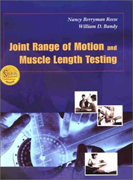This practical guide provides explanations of the techniques for
measuring both joint range of motion and muscle length testing. In
addition to the comprehensive coverage of the measurement techniques,
this text provides valuable information on measuring norms and a
critical review on the reliability of specific tests. It demonstrates
the use of the goniometer, inclinometer, and tape measure for the
examination of the upper and lower extremities, spine, and
temporomandibular joint. Readers will find the most complete
information available to date on measurement of joint ROM of the
spine, as well as muscle length of the upper and lower extremities.
차 례
Sect. I Introduction
1 Measurement of Range of Motion and Muscle Length: Background,
History, and Basic Principles 3
2 Measurement of Range of Motion and Muscle Length: Clinical
Relevance 43
Sect. II Upper Extremity
3 Measurement of Range of Motion of the Shoulder 63
4 Measurement of Range of Motion of the Elbow and Forearm 79
5 Measurement of Range of Motion of the Wrist and Hand 91
6 Muscle Length Testing of the Upper Extremity 127
7 Reliability and Validity of Measurements of Range of Motion and
Muscle Length Testing of the Upper Extremity 149
Sect. III Head, Neck, and Trunk
8 Measurement of Range of Motion of the Thoracic and Lumbar Spine 169
9 Measurement of Range of Motion of the Cervical Spine and
Temporomandibular Joint 209
10 Reliability and Validity of Measurement of Range of Motion for the
Spine and Temporomandibular Joint 251
Sect. IV Lower Extremity
11 Measurement of Range of Motion of the Hip 283
12 Measurement of Range of Motion of the Knee 301
13 Measurement of Range of Motion of the Ankle and Foot 307
14 Muscle Length Testing of the Lower Extremity 339
15 Reliability and Validity of Measurements of Range of Motion and
Muscle Length Testing of the Lower Extremity 367
App. A Capsular Pattern Defined 393
App. B: Sample Data Recording Forms 395
App. C Normative Range of Motion for the Extremities and Spine in
Adults 401
Index 427


